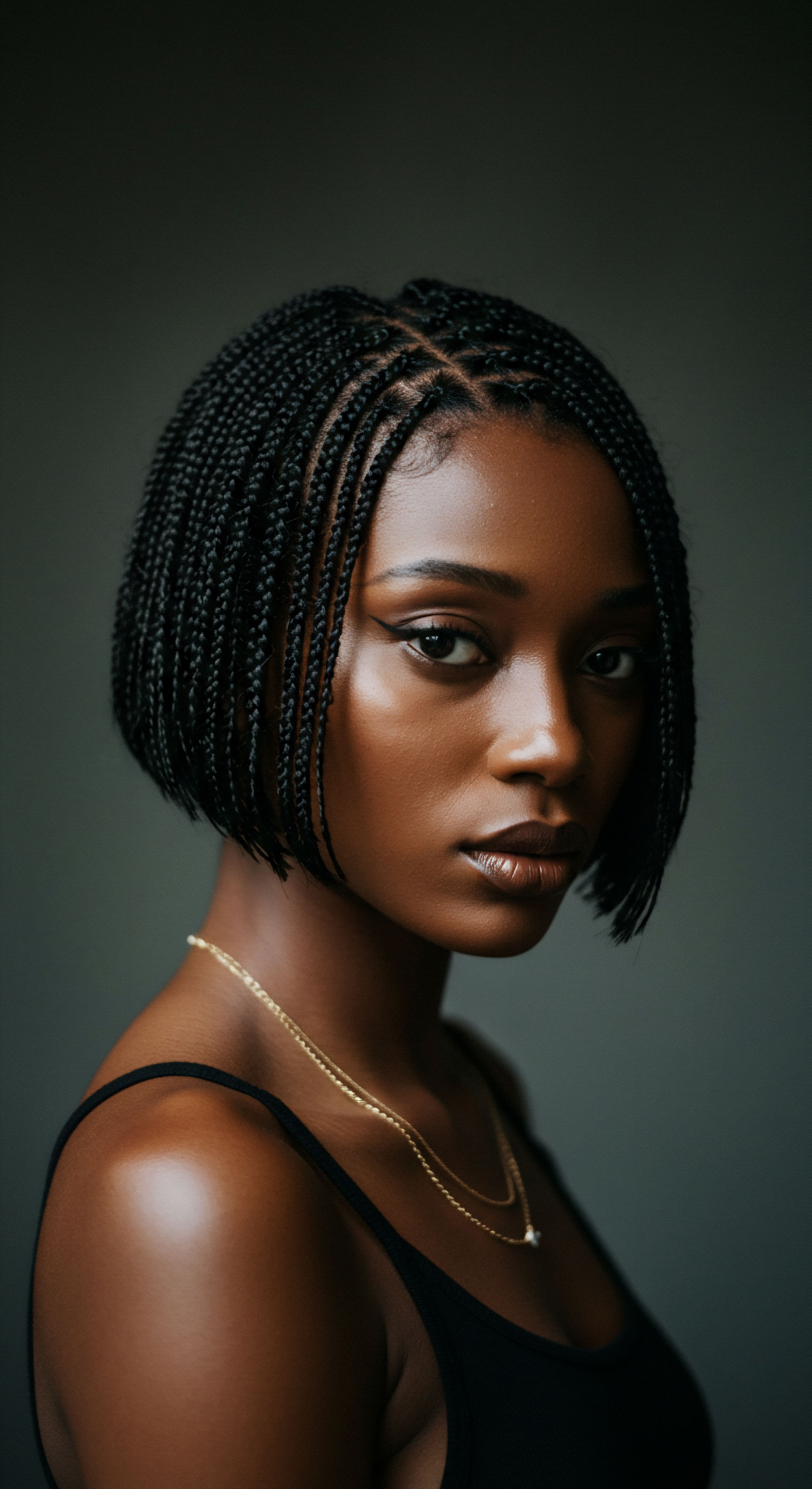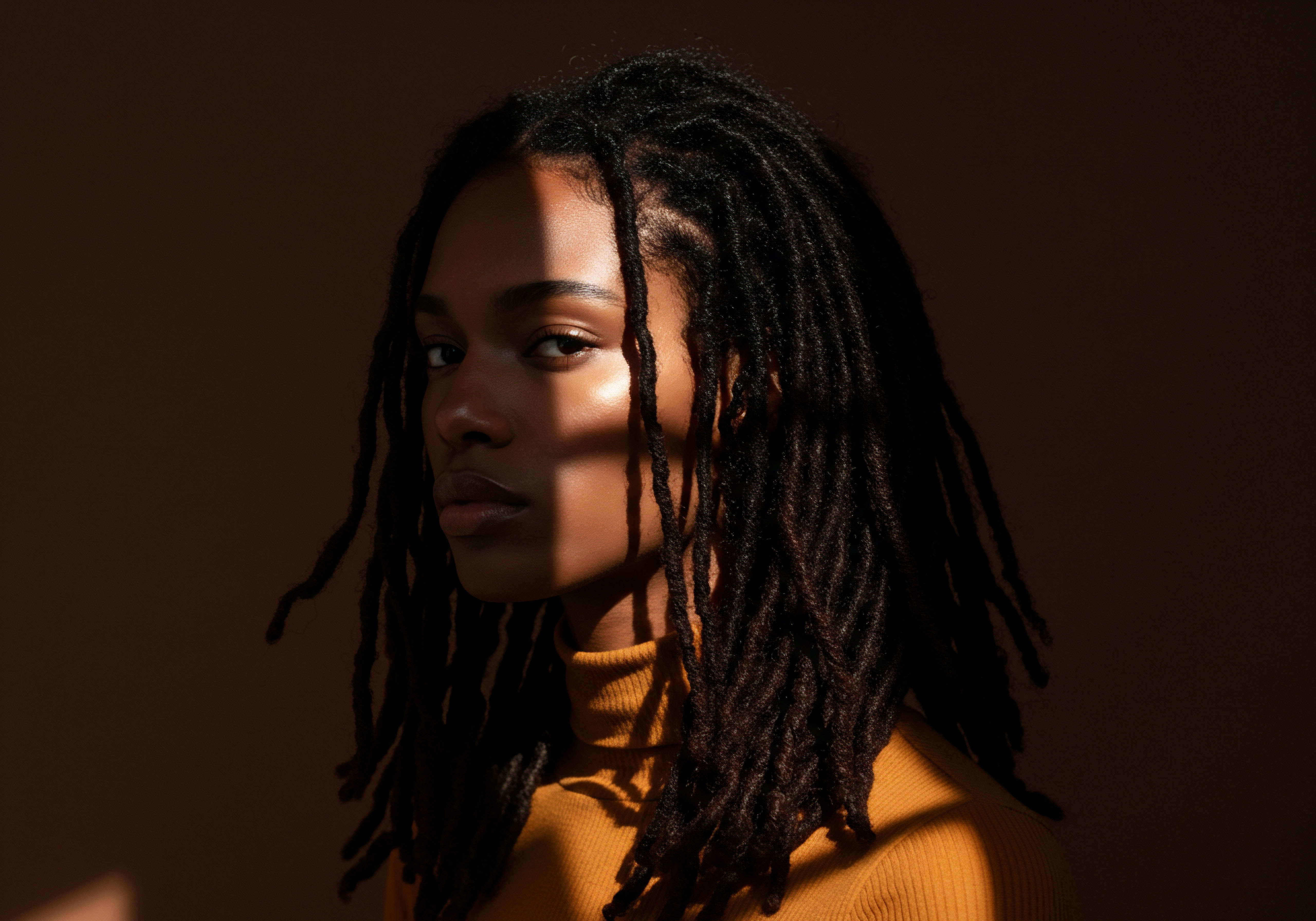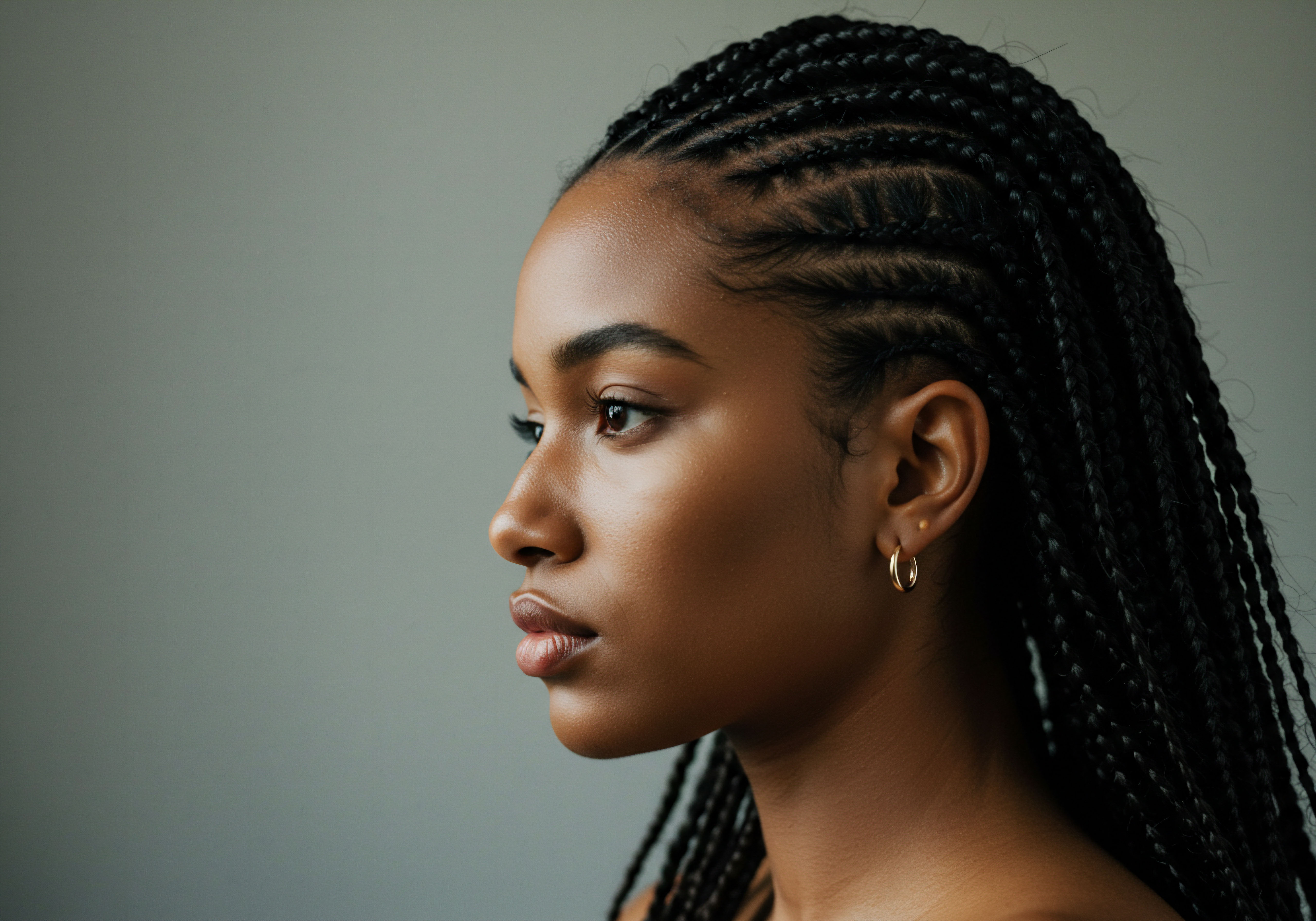
Roots
Our strands, in their exquisite variety, hold stories—tales of lineage, of sunlight, of moisture in the air. For those with textured hair, these stories are particularly vibrant, deeply personal, and often shaped by the very air around us. To truly comprehend how environmental shifts whisper changes upon our hair’s outermost layer, we must first bow to the fundamental structure of each strand. Consider it a tiny, living marvel, a testament to nature’s artistry, constantly engaging with its surroundings.
The outermost layer of our hair, the Cuticle, serves as its primary shield. Imagine it as a series of overlapping scales, much like shingles on a roof, all facing towards the hair’s tip. These delicate, transparent cells, numbering typically between six and ten layers, guard the inner cortex, where our hair’s strength and color reside. The condition of these scales dictates much of what we perceive as hair health ❉ its shine, its softness, its resilience.
When these scales lie flat and smooth, light reflects evenly, giving hair a lustrous appearance. When they are raised or damaged, light scatters, leading to a duller look and a rougher feel.

Anatomy of the Hair’s Outer Shield
Each individual hair fiber, a slender filament, emerges from its follicle, a tiny organ nestled within the scalp. While we often speak of hair as a singular entity, it is, in truth, a complex biological structure. The cuticle, composed of dead, keratinized cells, forms the outermost boundary.
These cells contain specific lipids, particularly 18-methyleicosanoic acid (18-MEA), which coat the surface, contributing to the hair’s natural hydrophobicity – its ability to repel water. This lipid layer acts as a crucial protective barrier, reducing friction and helping to maintain the hair’s internal moisture balance.
Beneath the cuticle lies the Cortex, the thickest part of the hair shaft. This region consists of elongated, spindle-shaped cells made primarily of keratin proteins. The cortex provides hair with its tensile strength, elasticity, and determines its curl pattern.
Pigment granules, known as melanin, which dictate our hair’s natural color, are also housed within the cortical cells. At the very center of some hair types, a soft, inner core, the medulla, may be present, though its exact biological purpose remains a subject of ongoing study.
The cuticle, a delicate outer layer of overlapping scales, serves as the hair’s primary defense against environmental influences, its integrity determining much of our hair’s visual health.

Hair’s Microscopic Design
Understanding the hair’s microscopic design provides clarity on how external forces begin their interaction. The unique architecture of textured hair, characterized by its elliptical cross-section and numerous twists and turns along the fiber, inherently positions its cuticle differently than straighter hair types. These twists naturally create points where the cuticle layers may be slightly lifted or more exposed, contributing to textured hair’s characteristic porosity. This structural variation means that environmental elements do not interact uniformly across all hair types, underscoring the necessity for a specific understanding of textured hair’s response.
- Cuticle Cells ❉ Overlapping, flattened cells forming the outermost protective layer.
- 18-MEA Lipids ❉ A fatty acid on the cuticle surface, vital for water repellency and smoothness.
- Cortex ❉ The central, protein-rich core providing strength, elasticity, and color.
When we consider environmental shifts, we are looking at how elements like varying humidity, air quality, and solar radiation engage with this protective outermost layer. The initial engagement is often subtle, a gentle alteration of the cuticle’s surface properties, but these seemingly minor changes can initiate a cascade of effects that impact the entire strand.

Ritual
The dance between our textured hair and the surrounding world is a daily performance, often calling for a thoughtful choreography of care. As we seek to understand how environmental shifts reshape the outermost layer of our strands, our attention turns to the practical wisdom and daily practices that can either support or hinder our hair’s resilience. It is in these moments of ritual – from our cleansing choices to our styling methods – that we truly engage with the hair’s external reality, seeking to fortify its defenses against the ever-changing atmospheric embrace.
Consider the impact of humidity, a frequent companion in many climates. When the air becomes heavy with moisture, water molecules are drawn to the hair. For textured hair, which often possesses a more open cuticle structure due to its natural coils and curves, this absorption can be particularly pronounced. The cuticle cells, designed to lie flat, may begin to swell and lift as they absorb water.
This lifting disrupts the smooth surface, leading to increased friction between individual strands and the familiar appearance of Frizz. This isn’t merely a cosmetic concern; it signals a compromised cuticle, leaving the inner cortex more vulnerable.

Cleansing and Conditioning in Changing Climates
The way we cleanse our hair plays a significant role in how its outermost layer responds to environmental shifts. Harsh cleansers can strip the hair of its natural lipids, including the protective 18-MEA layer on the cuticle. When this happens, the cuticle becomes even more susceptible to environmental influences, absorbing moisture more readily in humid conditions or losing it more quickly in dry air. A gentle, sulfate-free cleanser, followed by a conditioning treatment that helps to smooth and seal the cuticle, becomes more than a choice; it becomes a necessity for maintaining cuticle integrity.
Daily care rituals, from gentle cleansing to thoughtful conditioning, are vital in helping the hair’s outer layer adapt to environmental changes, preserving its strength and appearance.
Conditioners, particularly those rich in humectants and emollients, assist in replenishing the hair’s moisture content and laying the cuticle flat. Humectants draw moisture from the air, while emollients create a protective film, smoothing the cuticle and reducing moisture loss or excessive absorption. This careful balance helps to mitigate the effects of fluctuating humidity, reducing frizz and maintaining the hair’s supple feel.

Styling for Protection
Our styling choices also act as a buffer against environmental stressors. Protective styles, where the ends of the hair are tucked away, reduce exposure to direct sunlight, wind, and airborne particulates. Styles that minimize manipulation also limit mechanical stress on the cuticle, which can otherwise cause the scales to chip or lift. Even simple practices, such as using a wide-tooth comb on wet hair, can make a significant difference in preserving the cuticle’s delicate structure.
| Environmental Factor High Humidity |
| Cuticle Response Swelling, lifting of scales |
| Impact on Hair Feel/Look Frizz, loss of curl definition |
| Environmental Factor Low Humidity/Dry Air |
| Cuticle Response Loss of internal moisture, rigidity |
| Impact on Hair Feel/Look Dryness, brittleness, breakage |
| Environmental Factor UV Radiation |
| Cuticle Response Degradation of lipids/proteins, melanin oxidation |
| Impact on Hair Feel/Look Dullness, color fade, weakness |
| Environmental Factor Air Pollution |
| Cuticle Response Particulate accumulation, oxidative stress |
| Impact on Hair Feel/Look Roughness, dullness, loss of strength |
Heat styling, while offering versatility, can significantly alter the cuticle. High temperatures can cause the cuticle scales to lift and even crack, especially with repeated exposure. When the hair is wet, heat can cause rapid expansion and contraction of the cuticle cells, leading to micro-fissures.
If heat is a part of your ritual, a heat protectant becomes an indispensable tool, forming a barrier that helps to distribute heat more evenly and shield the cuticle from direct thermal assault. This thoughtful application of products and techniques becomes a personal armor for the hair, helping it stand resilient against the unseen forces of the atmosphere.

Relay
Moving beyond the immediate sensory experience of hair, we arrive at a deeper inquiry into the environmental influences that sculpt its outermost layer. This journey calls for a closer examination of the unseen forces, the subtle yet persistent pressures that leave their mark. How do the atmospheric elements, often imperceptible, orchestrate long-term transformations upon the very surface of our textured hair, and what do recent investigations tell us about these silent shifts?
The interplay of air quality, solar radiation, and fluctuating moisture levels presents a complex challenge for the hair’s outermost layer. Air pollutants, such as particulate matter and volatile organic compounds, do not simply rest upon the hair; they adhere to its surface, some even penetrating the cuticle. These pollutants, particularly when combined with solar radiation, trigger a process known as Oxidative Stress.
This chemical assault generates reactive molecules that degrade the hair’s structural proteins, including keratin, and its protective lipids. The consequence is a gradual weakening of the cuticle’s integrity, leading to a rougher surface, increased porosity, and a diminished capacity to retain vital moisture.

Pollution’s Silent Alteration of Hair’s Outer Layer
Research highlights the insidious impact of air quality on hair health. Studies indicate that hair exposed to higher concentrations of pollution experiences increased damage to both its cuticle and cortex. This damage manifests as a brittle, rough, and dull appearance. Beyond surface effects, airborne toxins can affect the hair’s pigmentation.
For instance, polycyclic aromatic hydrocarbons (PAHs), common components of air pollution, can absorb ultraviolet light, intensifying the adverse effects of UV radiation on hair. These PAHs, when present in hair melanin, contribute to premature graying and hair bleaching. This chemical interaction points to a deeper, more concerning alteration than simple surface dirt.
Environmental pollutants and UV radiation together orchestrate oxidative stress, degrading hair proteins and lipids, ultimately compromising the cuticle’s protective role and leading to visible changes.

The Distinctive Permeability of Textured Hair
A significant area of scientific inquiry concerns the inherent differences in hair structure across various populations and how these differences influence environmental responses. A study comparing ethnic hair types found that African Hair Exhibited Increased Permeability and a Lower Order Bilayer of Cuticle Lipids Compared to Caucasian or Asian Hair. This distinction is crucial. A lower order lipid bilayer means the protective lipid barrier on the cuticle surface is less tightly packed.
This structural characteristic implies that textured hair may be inherently more susceptible to absorbing water from humid environments, leading to more pronounced swelling and lifting of the cuticle. Conversely, it might also lose moisture more readily in dry conditions.
This increased permeability also suggests a greater propensity for pollutants and other environmental aggressors to infiltrate the cuticle and potentially the cortex. While the melanin in darker hair provides some photoprotection against UV radiation, the combined assault of pollution-induced oxidative stress and UV exposure can still lead to significant protein loss and cuticle degradation. The hair’s natural defenses, while present, are constantly challenged by these external forces.
- Cuticle Permeability ❉ Textured hair’s cuticle, with its distinctive lipid arrangement, may absorb and release moisture more readily.
- Oxidative Stress ❉ A chemical reaction caused by pollutants and UV, leading to protein and lipid degradation in the hair.
- Hygral Fatigue ❉ The repeated swelling and contraction of hair from humidity changes, causing stress and breakage.
The concept of Hygral Fatigue becomes particularly relevant here. When textured hair repeatedly absorbs and releases moisture due to fluctuations in humidity, the constant swelling and de-swelling of the hair shaft places immense stress on the cuticle cells and the underlying cortex. This cyclical stress can lead to micro-cracks and lifting of the cuticle scales, further diminishing the hair’s protective capabilities and increasing its susceptibility to breakage. This is not merely a transient effect; it is a cumulative process that, over time, can significantly alter the hair’s mechanical properties and visual appeal.

Environmental Stressors and Hair’s Molecular Shifts
The impact of environmental shifts extends to the molecular level. UV radiation, for instance, directly damages the hair’s protein structure. UVB radiation primarily affects the cuticle, leading to morphological changes and attacking both melanin and protein fractions. UVA, with its longer wavelength, penetrates deeper into the cortex, causing color changes.
The combined effect of UV and pollution can lead to a decrease in 18-methyleicosanoic acid (18-MEA), the fatty acid crucial for cuticle smoothness and hydrophobicity, resulting in increased surface friction and reduced manageability. These molecular shifts underscore the need for a comprehensive understanding of how our hair interacts with its surroundings, urging us to consider protective measures that address both surface and deeper structural changes.

Reflection
Our textured hair, with its unique patterns and profound cultural connections, stands as a testament to both resilience and delicate responsiveness. The conversations surrounding its interaction with environmental shifts reveal not just scientific principles, but a deeper narrative of care, adaptation, and honoring natural beauty. Each strand carries a history, influenced by the sun’s embrace, the air’s touch, and the very water it encounters.
Understanding these influences, from the microscopic architecture of the cuticle to the cumulative impact of atmospheric elements, invites a thoughtful engagement with our hair’s well-being. It is a continuous dialogue, a gentle unfolding of knowledge that guides us towards practices that truly serve and celebrate the vibrancy of textured hair in an ever-changing world.

References
- Is Pollution Ruining Your Hair? Learn About its Impact on Hair Health. trichology. (2024).
- The Impact of Environmental Pollution on Hair Health and Scalp Disorders.
- How the Exposome Contributes to Cumulative Hair Damage. BeautyMatter. (2025).
- The Invisible Threat to Hair and Scalp from Air Pollution. Polish Journal of Environmental Studies. (2024).
- Impact of Environmental Stressors on Hair. NYSCC. (2021).
- Hair color changes and protein damage caused by ultraviolet radiation. PubMed. (2004).
- The cracking of human hair cuticles by cyclical thermal stresses. ResearchGate.
- Grades of cuticle layer damage assessed by TEM. ResearchGate.
- The Signs And Science Of Damaged Hair. MONPURE. (2022).
- Hair color changes and protein damage caused by ultraviolet radiation. ResearchGate.
- Ethnic hair ❉ Thermoanalytical and spectroscopic differences. Digital CSIC. (2019).
- Porosity and Resistance of Textured Hair ❉ Assessing Chemical and Physical Damage Under Consumer-Relevant Conditions. MDPI.
- Hair color changes and protein damage caused by ultraviolet radiation. Sci-Hub.
- A systematic review on the lipid composition of human hair. PubMed. (2022).
- Performance and Mechanism of Hydrolyzed Keratin for Hair Photoaging Prevention. Preprints.org. (2025).
- Performance and Mechanism of Hydrolyzed Keratin for Hair Photoaging Prevention. MDPI.
- Effects of chemical straighteners on the hair shaft and scalp. PMC – PubMed Central.
- An Overview on Hair Porosity. NYSCC. (2020).
- The Ethnic Differences of the Damage of Hair and Integral Hair Lipid after Ultra Violet Radiation. PubMed Central.
- The exposome impact on hair health ❉ etiology, pathogenesis and clinical features ‒ Part I.
- How Humidity Affects Different Hair Types. Better Not Younger. (2022).
- The Impact of Climate Change on Hair Health and How to Protect It. My Derma Store. (2024).
- Moisture in the Cuticle Sheath ❉ Effects on Hair Mechanical and Cosmetic Properties. (2022).